Months ago we’d made reservations to go on a day trip to Parque Nacional El Cajas located only
35kms northwest of Cuenca, Ecuador. The reason was that the park was one of the most beautiful
wilderness areas in Ecuador. According to Lonely Planet, it had a ‘wild,
primeval landscape of craggy hills and glacier-scoured valleys studded with a
breathtaking quantity of lakes – 235 at last count – glinting like jewels
against the mottled earth and rock surrounding them. Despite sitting on the doorstep
of a major city, there’s a tremendous sense of solitude, with visitors kept at
bay by the rain and fog that so frequently plague the area.’
When I asked Milton why several churches on the outskirts of town were white and had blue trim, he explained that was because the blue represented being closer to heaven
and the white symbolized purity. He smiled as he said there were 19 churches
just in the historic center of Cuenca itself.
On the drive to the national park, Milton explained that we’d
be walking first around a mountain lake that was at 10,100 ft. above sea level,
then driving to Tres Cruces, the
summit of the park at over 13,000 ft before hiking for almost three hours at close to 12,500 ft or 3800 meters above sea level or masl from now on.
Cuenca had grown hugely in the past 20 years. In 1999, the
population was about 200,000 people but now it was over half a million. The
increase was fueled in small part by the number of expats, mostly from Canada
and the US, who have moved to Cuenca because of the most lower cost of living.
Eucalyptus plants were brought from Australia in 1870. Milton told us that sixty percent of Cuenca’s water comes
from the soil as 50 kgs of soil retains 100 kgs of water. He said we’d soon be
able to see for ourselves how spongy and waterlogged the soil was. The
eucalyptus plants require 60 liters of water a day.
As we passed lots of cows, Milton said 50 persent of all the milk
produced in Ecuador is from this and one other state.
Milton commented how much he has noticed the weather having
changed in the last 20 years. As a child, there was often snow even in these lower elevations but that doesn't happen any longer. He laughed as he told us how the teachers
don’t have to spend long teaching about the seasons in Ecuador as there aren’t
any! It’s either hot when you’re at sea level or cold in the mountains. He later added, though,
Paper tree:
This was a quinoa bush, not
to be confused with the food of the same name, Milton made sure to tell us. It
only grows 1 cm a year; Milton estimated this one was 800 years old. Even
though it looked like a tree, it was a giant rose and not a tree at all.
A wild lupine plant:
Milton explained it was rich in calcium and protein and was thus very important
to indigenous people before Spaniards introduced cows.
Wild celery:
As we crossed a footbridge, we noticed changes in the
vegetation at this elevation.
Milton explained that rainbow trout were introduced here
many decades ago. It turned out to be bad for the environment because the
conditions were ideal for the trout to thrive but there were no predators to
counteract the numbers of trout. As a result, the authorities have encouraged
people to fish them as much as possible. There were no restrictions on the
numbers or size of trout that could be caught as long as poles were used
instead of nets. Mindy: Neill
Milton told us how exceptionally lucky we were with the weather that
day as it was one of only about 70 days a year with blue skies and few clouds
in this area. Normally, it was foggy. Believe me, we counted our lucky blessings with the beautiful day! The name of the lake was LLaviuco, a Quechua word. Quechua is the name of both a people of the central Andes and their languages.
These small shore birds were known variously as ‘Keys of the underworld,’ black coot or chicken of the water:
All the lakes in the park were connected by streams.
More eucalyptus trees:
Milton cautioned us to be wary of this trumpet flower or Devil’s Breath which had extremely
potent blooms. Depending on the dose of the hallucinogenic from the tree, its
psychedelic effects could render people to lose their will altogether for
anywhere from 2-15 days. He shared with us that his father-in-law was an
alcoholic and was given such a large dose by mistake, he landed up in hospital for
many days.
This area was more developed than the other side of the lake
because of the introduction of non-native species and because Germans established a brewery here in 1919 because of easy access to
clear, pure water. The brewery closed down in the 1940s.
Here, two plants were living together on the same vine.
This taxo fruit
was a member of the passion fruit family.
Another trumpet flower:
Milton showed us the difference between the primary and
secondary forests; the former were pure compared to the latter where there had
been ‘intervention,’ i.e. where other non-native plants like the eucalyptus and
cypress trees had been introduced.
The views as we crossed from the secondary to the primary forest across the lake were superlative.
Pumas, deer, foxes and goats inhabit these forests, according to Milton. An Andean bear with two rings around its nose was spotted a few weeks ago on a camera placed by research scientists.
Once we reached the other side of the lake, Milton explained that some local people believe having the Florapandio tree or Devil's Breath in
their backyards warded off evil spirits.
Milton explained that twenty percent of the people in
Ecuador were indigenous and many believed in the power of special spirits.
Milton was mestizo, i.e. not indigenous but had come to believe that some people
had certain powers. Because of the length of this post, the fascinating family story he shared and photos will be in the next post. Make sure you read it as it will be very intriguing!
Milton pointed out the moss and lichen in the forest on this side of the
lake; the former was about 30-60 years old and the latter 60-100 years old.
The very tiny, Callalue Plant helps to clean kidneys but can also
induce abortions.
This type of Orchid blooms all year; there is a continuous
cycle as each plant takes turns blooming. This was the first time I remember hearing about plants taking turns when to bloom. Isn't nature wonderful?!
A Baby Shoes Plant, a type of bromeliad; Milton commented that the pineapple plant is the most popular bromeliad.I was really enjoying the hike as it seemed far more like a botany lesson than a hike!
A look back over to where we'd started our hike on the more developed side of he forest.
An orchid species:
Since there were no snakes and no aggressive bugs in the colder Andean jungle, Milton stated he loved it.
Milton thought a fox had likely killed this bunny which had
short ears so it didn’t have to release much heat from its body like most
bunnies. He added it hadn’t been there yesterday when he had been hiking.
A bird from the turkey family:
The handrails were made from eucalyptus poles.
The jungle seemed to go on forever.
Seconds later, however we were at the closest point to the lake
where we saw torturas reeds which indigenous people use to make baskets, mats
and carpets.
It was apparent that walking around the lake was like experiencing a
micro-ecosystem. How incredibly fortunate we were to have Milton share his
knowledge of biology, geography and the flora and explain in such depth
what we saw.
This stream was the ‘mother’ of the Rio Tomebamba that we had walked along yesterday afternoon in downtown Cuenca. Dams had been built downstream to prevent
flooding.
Lina: I thought
of you when Milton pointed out this Volcanic Fuchsia Plant over the stream as I remember your
saying once you loved that color. Do you still?
Alpacas are only raised for their very fine wool in Ecuador
since it is so warm.
A pumamaki, a baby puma handprint, normally only seen in the
Amazon.
University students were collecting these leaves to study their
production in the forest.
Milton said our three-kilometer hike around the lake had been ‘our warm up hike’ in anticipation of the much harder one coming up!
Our last view of the lake:
The travel agency had to make reservations in advance with the national park staff because only a limited number of people were allowed in this section of the park to protect its fragile ecosystem.El Cajas National Park Map: We had just hiked around Llaviucu. We were then driving slightly northwest to the park summit at Tres Cruces and then hike for 2.5-3 hours at Toreadora. Thank goodness we had brought snacks along with us as we wouldn't be stopping for lunch until close to mid afternoon!
On the way to the park summit, Milton
explained that the men in the fields were not farmers but workers hired by the
owners in the city to tend to the animals and land.
We had to stop on the one-lane road as it was 'lunchtime' for the cows!
People didn’t realize the effects on the ecosystem when pine
trees were planted in the late 1980s as the oil from their leaves acidified the
soil which would never recover its original spongy feature.
Thank goodness we had Milton help us figure out which
animals were llamas versus alpacas on the road! He told us we could tell the difference as
the llamas had taller, longer faces. The llamas had almost disappeared in
colonial times but they were reintroduced by the Swiss in 1998 in the national
park. Economically, the llamas were not as viable as cows because their only
value was their wool compared to meat and leather from the cows.
The pine trees marked the border of the national park. We
were at 3800 masl, about 10,200 ft, an area called the high desert, and en route to Tres Cruces, at 4160 masl or about
13,100 ft. It wasn’t even a fourteener as Colorado’s mountains above 14,000
feet are called!
This was the closest Continental Divide from the Andes to
the Pacific Ocean. Normally, the Tres Cruces lookout is so cloudy people can’t
see anything. Again, we were so lucky that the weather held and we had such
marvelous views.
The views from the summit were stupendous but it was hard not to keep admiring the gorgeous beasts, too.
It was very chilly at the lookout and we both had had to proceed slowly walking there because of the high elevation.
Steven and I were both apprehensive how we would fare on the
hike because of the elevation and how strenuous it might be. Steven had had to
sign a waiver saying he was in good health and could withstand the rigors of
the hike because of his age. That had been daunting as you might imagine. I
wasn’t sure either how my feet would hold up on the uneven terrain since I had
broken both of them within the last year, and the right one just in June.
Milton had talked earlier about the spongy soil as it had such a high water content but to actually feel it underfoot was an absolute hoot. I think we all felt like we were about ten again as we bounced up and down on it!
Eighty percent of El Cajas National Park was covered with
this type of grass. Milton commented that the indigenous people used it for
their roofs.
This was a blooming type of bromeliad but each plant determined how long
it bloomed.
Milton informed us that rangers determine who can hike in
this area of the national park depending on the weather conditions as they vary so
quickly.
Milton said it was a common mistake for people hiking at
such high altitudes to panic when getting short of breath; the key was to
breathe slowly and deeply for five seconds instead.
This was a wild species of rosemary plant but unsuitable for cooking.
The paper trees grew near water only.
These posts were markers for trail runners, not something we were interested in doing!
The adorable, tiny balloon plant or globito was endemic to the park
and never opens. I thought they were so, so pretty.
To us, this plant, part of the Indian Paintbrush family, was totally backwards as the flower was actually the green part and the leaves were red! Have you ever heard of anything so amazing before?
During the rainy season, there’s a greater concentration of
temporary lakes in the park because the water level rises in the lakes and flows out into
streams.
This material, called Plantino
Rigido, was like a plastic carpet, Milton said, and good in swampy terrain
as it never sinks. It was one of the most unusual plants I've ever felt.
These men were digging a trench to prevent flooding during the rainy season.
More of the 'plastic' undergrowth:
These trees were endemic to the park. No fires were allowed when camping anywhere in the park because of the threat of causing a wildfire.
What a lovely view of the valley. Milton stated that we’d be
going around the lake and that our destination would be the last lake at the
bottom. He mentioned he had studied science in university and had been a guide
for six years and was licensed to escort tourists all over the country except
to the Galapagos.
This was a quinoa species, but again not the cereal, he
affirmed!
Our favorite park of the hike so far was seeing this
extraordinary jungle of mostly paper trees. Milton said other tourists had told
him it looked like scenes from the Lord of the Rings movies. I hadn’t seen them
but I just LOVED the colors and wild shapes of the vines and trees!
It was so other-worldly traipsing through this paper tree jungle!
Milton, one of the best guides we've ever had:
The sun cooperated by coming out for just two minutes – I was in hog heaven!
Guess all good things must come to an end as, all too soon in our opinion, we were out of the jungle. The views in front of us were still spectacular but just in a different way.
Achupalla, a tiny flower at the top blooms just once per
life before the wind disperses its seeds so other plants can grow elsewhere.
Ahh, the marvels of nature at work again.
This part of the hike was pretty strenuous as it was all uphill for a long stretch.
Gentian flowers:
More of the sweet balloon plants:
Nadine has represented Luxembourg as a high jumper in
international competitions for three years after being a hurdler. She had just
begun working for BMW in Munich after getting her master’s in economics and
engineering. Oliver worked for a political think tank, also in Munich.
Nadine and Steven having a hoot jumping up and down on the spongy soil!This reedy lake was just the first one; we still had more lakes to hike to and around!
The oregano plant helped people whose bodies collapsed from
the altitude. Milton said as long as he’s been a guide, he’s never been able to
determine who would or would not suffer from altitude sickness on one of these
long and admittedly tough hikes. A person's size or physical condition didn't seem to be factors how people fared at high altitude.
Shortly, we came across another lake, Tortura Lake, or reed lake.
The Valerian Plant was used to treat herpes.
The next lake we walked past was called Pato Quinoa.
We’d started from the bottom of the mountain in the forest in the middle of the photo.
At last, Milton said we could sit down; phew as this was the first time all hike we were given the opportunity to relax for ten minutes. There was no doubt Steven and I both slowed down Nadine and Oliver but they were very understanding and accepting of our slower pace. We were still proud knowing we had acquitted ourselves on the challenging hike.
After a very late lunch at a restaurant just outside
the park, we welcomed the long drive back to Cuenca. The driver let the four of us
off in front of a special place in town that you'll have to wait to read about in the next post!
Milton had set the bar extremely high for tour guides; he was phenomenal providing interesting tidbits of information all along the way and set a pace perfectly suited to our abilities. We've had some fantastic adventures on four continents but this ranked very near the top in terms of sheer natural beauty hour after hour, the physical challenge of the hike, the absence of almost any other hikers all day long, enjoyable companions in Nadine and Oliver and especially a first-class guide. We couldn't have asked for a more perfect experience in El Cajas National Park.Next post: Milton's tale about medicine women and our experience seeing them later that day!
Posted on October 23rd, 2017, from Ollantaytambo in the Sacred Valley, Peru.














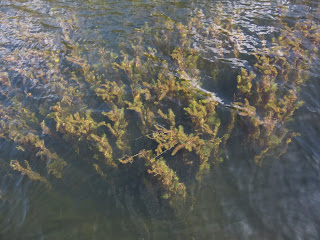




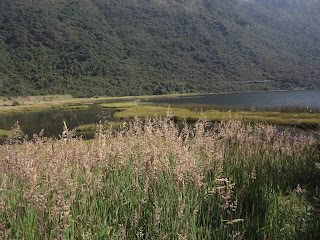
















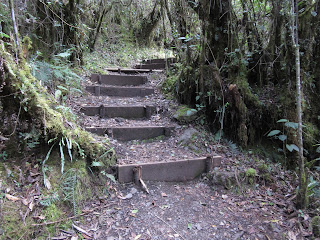


















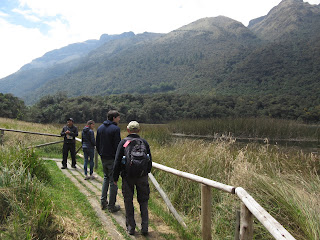








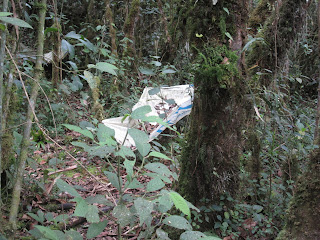










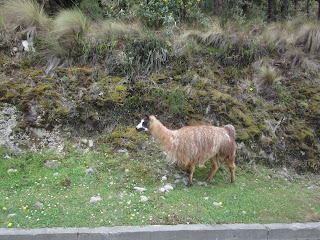
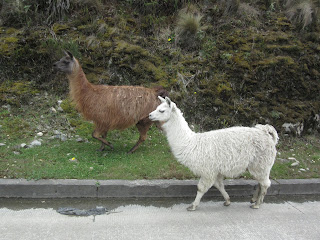








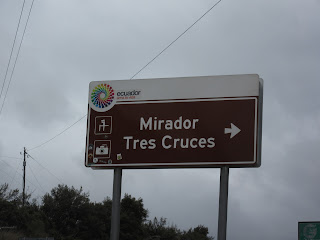








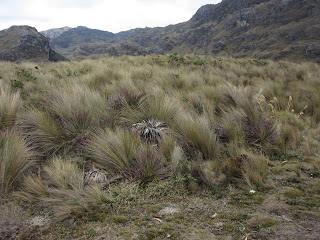

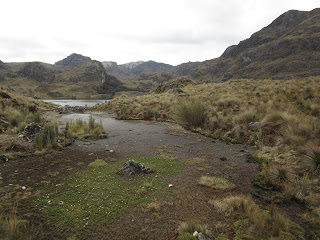


















































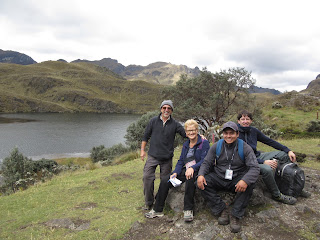


What a fabulous post Anne -- Milton truly was exceptional.. highly informed in botany, geography, zoology, ecology, altitude etc etc etc . Bravo to you both for embracing this challenging hike and keeping up with your elite athlete hiking mates from Luxembourg. And yes Anne, I do LOVE fuchsia.. such a happy shade of pink ! Much love to you both.
ReplyDeleteLina, It was a no-brainer accepting the 'challenge of the hike' when making the reservation months in advance from the comfort of our home back in Denver - that was the easy part! Milton, though, was such an expert guide that he made the hike feel so enjoyable and informative that the actual difficulty of the hike at such an high altitude was minimized.
DeleteGlad to hear fuchsia is still a favorite color. Love and hugs from Cusco, Peru.
The history and pictures are undeniably beautiful. Safe travels!
ReplyDeleteHadassah,
ReplyDeleteWonderful hearing from you. Glad you enjoyed reading about our hike near Cuenca. I imagine you and Zachary would have loved it too. Hope your job is going well and that your mother's health improves soon.
Hugs from Cusco, Peru.